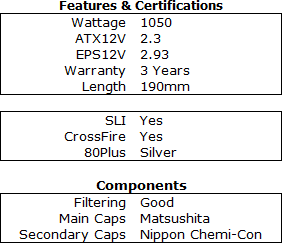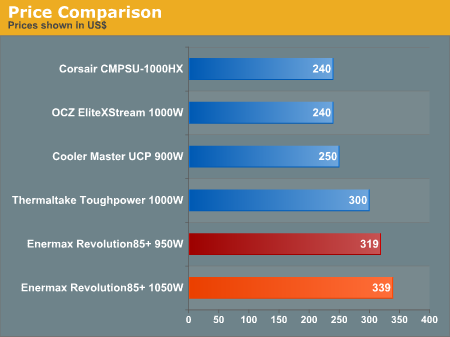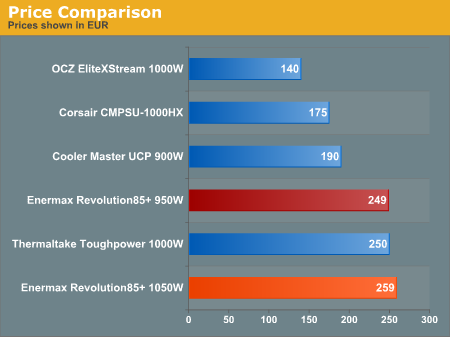Enermax Revolution 85+ High Efficiency PSU
by Christoph Katzer on November 6, 2008 4:15 AM EST- Posted in
- Cases/Cooling/PSUs
Conclusion
Our expectations for this power supply were very high, but we are happy to say that it met its potential in every way. Beauty as always is in the eye of the beholder, but we do like the appearance of the Revolution 85+. The original sample was far more conservative in its design, and when Enermax told us they were revising the look we didn't think it was necessary, since it would probably just increase the price. However, we have to say that the final result does look really cool. The combination of the black textured surface with the red highlights around the fan grille is very attractive in our opinion.
The feature list is similarly impressive, even though most users will not see or recognize some of the innovations. Enermax included a lot of new technologies in this power supply, and the results are very good. It starts with a good topology that lets the two transformers act in synchronization. Another nice feature is the DC-to-DC circuitry that increases efficiency. The not new but still good addition of the 12-pin sockets on the front of the power supply give potential support for future connector developments -- provided of course that the voltage requirements don't change.
The length of the ATX and PEG cables is long enough for most systems. However, if you want to install this power supply in a case where the PSU is in the top rear and the hard drives are in the bottom front, you may have some difficulties getting the cables to reach. Likewise, if the PSU sits in the bottom of your case you might not be able to route all of the cables nicely through the chassis but will have to take a more direct path. The eight 6/8-pin PEG connectors are very nice and make this power supply ready for any GPU configuration all the way up to triple SLI and more. If you're going to use multiple graphics cards, this PSU will likely work best in a bottom-mounted location.
Build quality has never been a concern with Enermax products. About the only problem we've ever encountered were some incompatibilities in the past with a few specific motherboards. Those issues never occurred with higher end PSUs, however, and the Revolution 85+ is clearly the highest of their high-end power supplies. They have included all of the best features from their previous offerings, plus a few new ones for good measure. All of this adds up to the tremendous performance we saw today.
Voltage regulation was good and not even our 10% overload test could cause this unit to sweat. The efficiency is the best we have seen from any previous power supply to date. Enermax states on the package that up to 90% efficiency is possible, and we achieved exactly that with 230VAC. Even with a lower 120VAC input, efficiency still reached an incredible 88%. As mentioned, optimal efficiency generally requires a minimum load of 200W; if you have a system that idles above 200W, you won't need to worry about power supply efficiency for a long time.
Another nice feature is the no load function. As we hinted at earlier, we loaded the power supply using only the 12V rails, keeping the lower voltage 3.3V and 5V rails load-less. We had no trouble at all pulling up to 1000W on the 12V rails without any lower voltage rails, and the PSU still maintained a very nice regulation of just a few millivolts under 12.00V. Of course, with a DC-to-DC circuit the power supply has no total combined power anymore. For reference, when we tried this test on other power supplies, they immediately shut down when either the 3.3V or the 5V rail didn't have any load.
 |
The heatsinks stayed very cool during testing, with temperatures lower than 40°C. Only after running at 110% for a longer period of time did we manage to get heatsink temperatures above 40°C. The fan speed begins increasing with 500W of load and actually lowers temperatures slightly for a while; it's only from 1050W onwards that the heatsink temperatures rise again and the fan can't quite keep up. The drawback is that noise levels are slightly higher than the temperatures warrant; we measured only 29dB(A) under highest load which is still an extraordinary result, but it should have been possible to keep noise levels down even further since the heatsinks aren't that hot at all. Still, it's always better to have a cooler running power supply than to toe the line, which is why Enermax regulates temperatures and fan speeds in this fashion. Keeping the internals at around 40°C at all times is not at all a bad approach, and this should increase the lifespan for this power supply.
Let's compare this unit to other 1000W units and see where it fits. Let's start with the Cooler Master UCP, since there are similarities with the Enermax Revolution 85+. The Revolution 85+ comes with about the same amount of cables and connectors. The PEG connection options are similar but the UCP has them further from the PSU, which is better for users since that provides for better cable routing options. However, Enermax has six 6/8-pin PEG connectors, giving the user greater flexibility. The Corsair HX1000W is also very similar. Compared to units from our 1000W roundup last year, the Enermax Revolution 85+ outperforms all of them. There are more connectors on power supplies now, since manufacturers have discovered that they have plenty of headroom. Power supplies also sport 6/8-pin connectors as well rather than just providing 6-pin PEG, which is a good addition.
In voltage distribution, we don't see really much difference between the Revolution 85+ and many of the competing units tested this year. The Corsair HX1000W has a very good regulation as well, so the Enermax unit has no advantage in this regard. However, when it comes to efficiency there's not much to compare -- after all, we already said the Revolution 85+ is the most efficient power supply we have tested to date. The HX1000W achieves up to 86% and the Cooler Master UCP is close with up to 89% efficiency. This brings Cooler Master back into the game, but if we compare all the additional features (i.e. safety and protection) Enermax leaps ahead again.
The final comparison is pricing. Since each "revolutionary" product that enters the market is usually more expensive than the preceding units, we are not expecting wonders here. We'll let the numbers do the talking:


As expected the MSRP for both units we listed is far above everyone else in the U.S. The Corsair HX1000W is similarly equipped with connectors and offers a wide range of features as well. For a price of around $240 it is a true bargain compared to the others in the list. Still, the Enermax Revolution 85+ offers more and we need to keep in mind that we are using MSRP for now -- street prices will almost certainly be lower. In Europe OCZ sells its EliteXStream for an extremely low price of only 140€, but the others all come close to the Enermax MSRP. Prices should also drop as availability improves, though Enermax will keep it above a certain level as we have seen with the Galaxy series. Enermax knows its advantages over the competition and that will result in prices that should stabilize slightly higher than competing products.
 |
Even though these power supplies are anything but cheap, we are confident in making the statement that the Enermax Revolution 85+ is currently the most advanced consumer power supply available. It offers exceptional efficiency, voltage regulation, temperatures, and has very good build quality. It doesn't necessarily surpass the competition in every area, but it's always at the top of the charts. Ultimately, the innovations, feature set, and performance impress us so much that we are pleased to award the Enermax Revolution 85+ our Gold Editors' Choice Award. It's entirely possible that if you purchase the 1050W model, you could end up running the same PSU for the next couple of presidential elections -- and you can do so knowing your PC will be as green as a hybrid SUV.










49 Comments
View All Comments
takumsawsherman - Thursday, November 6, 2008 - link
Forgive me for my ignorance, but isn't it the 5V rail that takes care of hard drive power? The reason I ask is that I have a Enermax Whisper 350 that is about 5 years old, and it has 32A on the 5V rail. I can use 4 Hard drives max before the power supply starts to have issues.Does this mean that this power supply could only handle 3? My 3.3 rail is also 30A, and this unit seems to only provide 25. Why so little?
Again, I am looking to be educated, I'm not yet criticizing because I realize that my assumptions are probably incorrect. I've been window shopping for Hard drives for a while now (750GB is not enough any more) and I know i can't add more to my current setup unless I get a better power supply.
Trippytiger - Friday, November 7, 2008 - link
I believe 3.5" hard drives receive power on both the +5V and +12V rails. That the power supplies for external hard drive enclosures provide both voltages suggests this.I'm guessing, given how old your PSU is and how much juice it has on the +5V and +3.3V rails, that its +12V rail is on the weak side and that's the reason it has issues with large numbers of hard drives. It sounds like it was designed to ATX 1.3 specs and was intended for system with a CPU running off of the 5V rail. Since all modern (and not so modern) processors take power from the +12V rail these days, the +5V rail just isn't as critical as it used to be.
You'd probably be much better off with a newer PSU with more power on the +12V rail. Of course, if your system does happen to be ancient... good luck finding something suitable. I went shopping for a PSU for my old AXP+ system several years ago and had a hell of a time finding a unit with a beefy +5V rail back then!
xaris106 - Thursday, November 6, 2008 - link
I`m not sure i understand that "syncronized transformers". But if they work in parallel I am a bit concerned for the approach as variations in the resistance, impendance and coupling factors between the two can lead to unbalanced loading. And it could get worse as components burn in and age.As for the kill a watt measurements I would like to point out that the number is not what the pc components need in power. It includes the psu loses. that means a 300W kill-a-watt measurement means the parts draw 240W (and the psu load) with a 80% efficient psu
JonnyDough - Thursday, November 6, 2008 - link
Try learning words like "kilowatt" and "losses" and then post.xaris106 - Thursday, November 6, 2008 - link
yeah I see why you said that... with "kill-a-watt" i was referring to the wattmeter device that people use in their electric outlets to measure power consumption. I wasn't referring to killowatts...I also misspelled "losses". again sorry for my english.The0ne - Friday, November 7, 2008 - link
You don't need to apologize for your grammar or misspellings on here. People need to understand that there are other members of different race and from different countries to not STUPIDLY assume that they are the only one that matters in the world. If the person is going to make such stupid comments lets see him/her try it on a non-english topic and then report back. Chances are, he/she is probably to lazy in the first place to pick up a second language to even consider trying.That aside, it's the web. Even I don't care about my grammar or spelling here and I write technical reports on a daily basis where I work (to a certain extent of course hahah).
JarredWalton - Friday, November 7, 2008 - link
The power loads in our PSU reviews are *not* measured using a Kill-A-Watt or similar device; see the page on the Chroma testing equipment. When we say there's a 500W load on a PSU and that PSU is 89% efficient at that load, it means the PSU is drawing 562W at the outlet. Our other articles use wall power (because we don't have the equipment elsewhere to measure actual loads).xaris106 - Friday, November 7, 2008 - link
Yes, I know you didn't use a simple wattmeter. Your equipment and test is impressive I would say. I was referring to a comment in page 1 that mentioned a kill-a-watt.As a suggestion, in reviews that you do use outlet power, it would be nice to make a note of it and that the numbers include power losses (and even the approximate efficiency if you use a tested psu) so people can have it in mind.
Now just an idea.Wouldn't it be nice for you to make a set of connectors that plug between the psu connectors and the motherboard/devices that can go through ampmeters? So we can see all those dc currents. Although that might me a lot of ampmeters...and a bit risky. Just a thought.
My regards.
The0ne - Friday, November 7, 2008 - link
I don't see why you can't hook up a current probe connected to a O-scope to measure the current.JarredWalton - Friday, November 7, 2008 - link
Christoph did something like that in his http://www.anandtech.com/casecoolingpsus/showdoc.a...">Power Supply Myths article... not really something to do in every review if we can avoid; they take long enough already! ;)